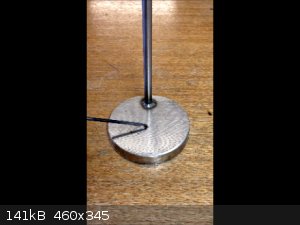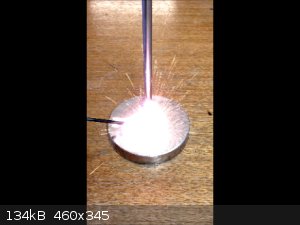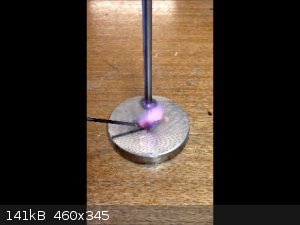agent_entropy
Hazard to Self
 
Posts: 91
Registered: 17-7-2006
Location: U.S.
Member Is Offline
Mood: No Mood
|
|
Copper (I) Acetylide
Sorry if this should be in another copper acetylide thread but it didn't seem to fit the real topic of any of them. Mods feel free to merge if
appropriate.
I'm looking for a little confirmation by someone with experience with copper (I) acetylide (cuprous acetylide). I'm interested in copper (I) acetylide
for electric matches.
There seems to be some contradiction in the literature:
In "Chemistry of Powder and Explosives" by Tenney L. (page 5) it states:
"Cuprous acetylide, of which only a very small quantity may be prepared safely at one time, is procured by bubbling acetylene into an ammoniacal
solution of cuprous chloride. It precipitates as a brick-red powder. The powder is collected on a small paper filter and washed with water. About 0.1
gram of the material, stHl moist, is transferred to a small iron crucible—the rest of the cuprous acetylide ought to be destroyed by dissolving in
dilute nitric acid."
However, in "Chemistry and Technology of Explosives" by Urbanski, T. (volume 3, page 227-228) it states:
"The heavy metal salts of acetylene have the properties of primary explosives, but only cuprous acetylide was found to be satisfactory for practical
use."
Later in the section it is mentioned that:
"Cuprous acetylide is used as the chief component of match heads in electric fuses, being particularly susceptible to ignition by sparks or a glowing
wire to give a sharp, hot flame."
Furthermore, Urbanski and those he cites recommend the preparation of cuprous acetylide in the presence of a reducing agent such as hydroxylamine or
SO2 so as to prevent the formation of unstable cupric acetylide (copper (II) acetylide).
Sam Barros PowerLabs http://www.powerlabs.org/chemlabs/acetylide.htm (bottom of page) mentions the preparation of "Copper Carbide" (copper valence state unclear), but
says that copper carbide is easily decomposed in water and that the synthesis must be carried out rapidly and drying must be immediate.
My questions are:
-Are Tenney, and Barros talking about mixed valences of copper acetylide? Would that mean that the material Tenney is talking about is unstable
(unsafe) because it contains copper (II) acetylide?
-Are either cuprous or cupric acetylide actually decomposed by water?
-If cuprous acetylide is a primary explosive how can it be used as an electric match without detonating, but rather to provide a "sharp, hot flame"?
-Is copper (I) acetylide oxidized by atmospheric oxygen like other copper (I) salts are?
-Would an inert gas blanket be beneficial to the synthesis of cuprous acetylide or is the reducing agent sufficient?
[Edited on 13-6-2016 by agent_entropy]
|
|
|
hissingnoise
International Hazard
    
Posts: 3940
Registered: 26-12-2002
Member Is Offline
Mood: Pulverulescent!
|
|
| Quote: | | Are either cuprous or cupric acetylide actually decomposed by water? |
I don't know that cupric acetylide exists but cuprous acetylide is stated to react with water...
Though its explosion produces no gasses it will damage objects that are in close proximity.
There are much safer alternatives!
|
|
|
Marvin
National Hazard
   
Posts: 995
Registered: 13-10-2002
Member Is Offline
Mood: No Mood
|
|
Might not be a contradiction, Davis and Urbanski are writing at different times and to different audiences. It's also possible Urbanski has no
personal experience with the material which may need to be processed in an oxygen free atmosphere. It probably isn't worth trying to second guess the
differences between the sources. Explosives behaving in different ways under different circumstances is normal. Red match heads burn quite slowly
but wrap one in foil and heat it with another match and the detonation is quite loud. Red match heads have blown a lot of fingers off people trying
to make rockets with them.
|
|
|
Chemetix
Hazard to Others
  
Posts: 376
Registered: 23-9-2016
Location: Oztrayleeyah
Member Is Offline
Mood: Wavering between lucidity and madness
|
|
Cu(I) Acetylide seemed an interesting compound for a number of reasons, so I gave a small gram sized synthesis a go. If it is to be used as a
nuclueophile in synthetic chemistry I wanted to know how unstable the substance is. From the results of this study it turns out to be rather
underwhelming.
As for its' impact sensitivity, it took a good blow from a hammer on a clean steel surface to get even a crackle and a few wayward sparks. It would
flash like NC when exposed to a hot wire or flame. Confining a sample in a drinking straw and a chinese style cracker fuse taped in for confinement,
gave not much more than an insipid puff and the remnants of the fuse spat out. The only other safety note to mention is that it does stain the skin
like silver nitrate, although not as persistently. I've tried to find anything meaningful as to its' toxicity and found practically nothing. If anyone
knows more about this aspect I'd appreciate it.
The synthesis from Cu(ii) SO4 was fairly straight forward. A stoic. amt. of
Cu(ii) SO4 and NaCl was put in a large TT and dissolved in H2O. A stoic. XS amt. of sodium metabisulphite based on the available SO2 was added along
with a drop or two of 32%HCl to get things going. A ppt of Cu(I)Cl drops out immediately and with a few drops of HCl to drive the reaction to
completion. Decant and rinse with distilled H2O a few times and use as is. Add H2O to make 1/2 full. Bubble NH3 (from urea decomp rxn.) into TT until
solution is clear and rich royal blue and reeks of NH3. Bubble acetylene (industrial welding grade) into solution, a brick red ppt forms instantly.
When finished after a few minutes, settle, decant, rinse with EtoH, filter then dry.
I left some residues in the TT wet with water and EtoH for several days, after scraping a little out and then leaving to dry, they flashed the same as
the sample that was rinsed and dried properly. It didn't seem overly concerned that it was exposed to water. Out of curiosity I tried working with
Cu(II)Cl and there was no reaction with acetylene in NH3. Valency is definitely a factor when forming the acetylides.
I've attached some stills from the decomposition, the flash then the purplish cloud afterwards is interesting!
  
|
|
|
Metacelsus
International Hazard
    
Posts: 2544
Registered: 26-12-2012
Location: Boston, MA
Member Is Offline
Mood: Double, double, toil and trouble
|
|
If the solution was "rich royal blue", then there was some copper(ii) present. Complexes of copper(i) are colorless. If you have it, you can add
hydroxylamine to reduce this. (Also, what is TT?)
|
|
|
NeonPulse
Hazard to Others
  
Posts: 417
Registered: 29-6-2013
Location: The other end of the internet.
Member Is Offline
Mood: Isolated from Reality! For Real this time....
|
|
Test tube
|
|
|
Chemetix
Hazard to Others
  
Posts: 376
Registered: 23-9-2016
Location: Oztrayleeyah
Member Is Offline
Mood: Wavering between lucidity and madness
|
|
If you bubble the ammonia into a solution of either Cu(I)Cl or Cu(II)Cl2 they will both go a rich royal blue colour, although you will notice a
difference if you put them side by side. The Cu(I)Cl behaves a little differently as it's almost completely insoluble to begin with, and as the
concentration of ammonia increases a yellowish ppt starts to form then disappears and the rich blue predominates and becomes darker and richer. I
would think that there would be practically none of the Cu(II) ion to begin with, as after several rinses the supertanant is clear.
|
|
|
Metacelsus
International Hazard
    
Posts: 2544
Registered: 26-12-2012
Location: Boston, MA
Member Is Offline
Mood: Double, double, toil and trouble
|
|
It doesn't take much Cu(II) to cause the blue color. The small amount present probably wouldn't matter for this synthesis, but in general, Cu(II) will
cause oxidative dimerization of alkynes.
|
|
|